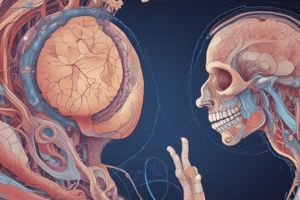Podcast
Questions and Answers
What is the significance of the laryngotracheal diverticulum during embryonic development?
What is the significance of the laryngotracheal diverticulum during embryonic development?
- It contributes to the formation of the lung bud. (correct)
- It forms the primordial pharynx.
- It is the initial section of the gastrointestinal tract.
- It creates the partition between the oropharynx and esophagus.
During which weeks of development do the longitudinal tracheoesophageal folds begin to form?
During which weeks of development do the longitudinal tracheoesophageal folds begin to form?
- 4th and 5th weeks (correct)
- 6th and 7th weeks
- 2nd and 3rd weeks
- 8th and 9th weeks
What does the tracheoesophageal septum separate within the cranial part of the foregut?
What does the tracheoesophageal septum separate within the cranial part of the foregut?
- The lungs from the bronchi
- The laryngotracheal tube from the esophagus (correct)
- The primordial larynx from the trachea
- The oropharynx from the respiratory pathway
In the development of the respiratory system, what structure does the dorsal part of the foregut develop into?
In the development of the respiratory system, what structure does the dorsal part of the foregut develop into?
What layers invest the elongating laryngotracheal diverticulum during its development?
What layers invest the elongating laryngotracheal diverticulum during its development?
What structure forms first during the development of the respiratory system?
What structure forms first during the development of the respiratory system?
From which embryonic layer does the connective tissue, cartilage, and smooth muscle in the respiratory system derive?
From which embryonic layer does the connective tissue, cartilage, and smooth muscle in the respiratory system derive?
Where is the laryngotracheal diverticulum located in relation to the foregut?
Where is the laryngotracheal diverticulum located in relation to the foregut?
What is the nature of the laryngotracheal diverticulum during embryonic development?
What is the nature of the laryngotracheal diverticulum during embryonic development?
Which structure is located caudal to the hypobranchial eminence during embryonic development?
Which structure is located caudal to the hypobranchial eminence during embryonic development?
During the development of the respiratory system, what direction does the laryngotracheal diverticulum elongate?
During the development of the respiratory system, what direction does the laryngotracheal diverticulum elongate?
What is the developmental significance of the laryngotracheal diverticulum?
What is the developmental significance of the laryngotracheal diverticulum?
During development, what does the laryngotracheal diverticulum originate from?
During development, what does the laryngotracheal diverticulum originate from?
At which stage of development does the lengthening of the respiratory diverticulum begin?
At which stage of development does the lengthening of the respiratory diverticulum begin?
Which embryonic structures provide the muscles of the larynx?
Which embryonic structures provide the muscles of the larynx?
What is the primary source of the cartilage and connective tissue of the trachea?
What is the primary source of the cartilage and connective tissue of the trachea?
At what stage of development do the bronchial buds first appear?
At what stage of development do the bronchial buds first appear?
Which cranial nerve is responsible for innervating all the muscles of the larynx?
Which cranial nerve is responsible for innervating all the muscles of the larynx?
What complication is generally associated with tracheoesophageal fistula?
What complication is generally associated with tracheoesophageal fistula?
What differentiates the endodermal lining of the laryngotracheal tube?
What differentiates the endodermal lining of the laryngotracheal tube?
At what week does the development of the trachea reach the stage illustrated in transverse sections labeled 'C'?
At what week does the development of the trachea reach the stage illustrated in transverse sections labeled 'C'?
Which structures are derived from splanchnic mesenchyme in lung development?
Which structures are derived from splanchnic mesenchyme in lung development?
At what gestational age does the major branching pattern of the lung show approximately 17 orders of branching?
At what gestational age does the major branching pattern of the lung show approximately 17 orders of branching?
What is the correct sequence of lung maturation stages?
What is the correct sequence of lung maturation stages?
What does the visceral pleura develop from?
What does the visceral pleura develop from?
Lung development occurs in which primary direction?
Lung development occurs in which primary direction?
Which of the following statements about the lung development process is correct?
Which of the following statements about the lung development process is correct?
Which of the following structures develops from the endoderm during lung embryogenesis?
Which of the following structures develops from the endoderm during lung embryogenesis?
During which stage of lung development do the terminal sacs appear?
During which stage of lung development do the terminal sacs appear?
What is the term for the opening of the laryngotracheal tube into the pharynx?
What is the term for the opening of the laryngotracheal tube into the pharynx?
Which of the following structures is derived from the mesenchyme of the 4th and 6th pharyngeal arches?
Which of the following structures is derived from the mesenchyme of the 4th and 6th pharyngeal arches?
During which weeks of development does the tracheoesophageal septum undergo successive stages?
During which weeks of development does the tracheoesophageal septum undergo successive stages?
What develops from the cranial most part of the laryngotracheal tube?
What develops from the cranial most part of the laryngotracheal tube?
From which part of the hypopharyngeal eminence does the epiglottis develop?
From which part of the hypopharyngeal eminence does the epiglottis develop?
What is another name for the laryngotracheal diverticulum?
What is another name for the laryngotracheal diverticulum?
Which of the following is not considered part of the developmental components of the larynx?
Which of the following is not considered part of the developmental components of the larynx?
Which fold becomes relevant in the development process of the larynx?
Which fold becomes relevant in the development process of the larynx?
What sequence is represented by the mnemonic 'GOOD DISSECTION FOR STUDENT TEACHING'?
What sequence is represented by the mnemonic 'GOOD DISSECTION FOR STUDENT TEACHING'?
Which of these cartilages is specifically mentioned as derived from the 5th pharyngeal arch?
Which of these cartilages is specifically mentioned as derived from the 5th pharyngeal arch?
Flashcards are hidden until you start studying
Study Notes
Development of Respiratory System
- The laryngotracheal diverticulum forms by the end of the 4th week.
- The laryngotracheal diverticulum is located ventral to the caudal part of the foregut.
- The laryngotracheal diverticulum is the first sign of respiratory system development.
- The laryngotracheal diverticulum is located caudal to the hypobranchial eminence and is in the floor of the developing pharynx.
- The laryngotracheal diverticulum is a midline evagination from the ventral wall of the pharyngeal part of the foregut.
- The laryngotracheal diverticulum extends in a caudal direction and elongates.
- The distal end of the laryngotracheal diverticulum enlarges to form the lung bud (respiratory bud).
- The laryngotracheal diverticulum separates from the primordial pharynx, but maintains communication with it through the primordial laryngeal inlet.
- The laryngotracheal diverticulum elongates and is invested by splanchnic mesoderm.
- Longitudinal tracheoesophageal folds develop in the laryngotracheal diverticulum and fuse to form a partition, the tracheoesophageal septum.
- The tracheoesophageal septum divides the cranial part of the foregut into the ventral part, the laryngotracheal tube (Primordium of the larynx, trachea, bronchi, and lungs) and the dorsal part, the primordium of the oropharynx and esophagus.
- The opening of the laryngotracheal tube into the pharynx becomes the primordial laryngeal inlet.
Development of the Larynx
- The larynx develops from the cranial most part of the laryngotracheal tube.
- The opening of the respiratory diverticulum into the foregut becomes the laryngeal orifice or inlet of larynx.
Developmental Components of the Larynx
- Laryngeal epithelium and glands are derived from the endoderm of the cranial part of the laryngotracheal tube.
- Cartilages of the larynx (Thyroid, Cricoid, Arytenoid, Corniculate, and Cuneiform) are derived from mesenchyme of the 4th and 6th pharyngeal arches.
- The epiglottis develops from the caudal part of the hypopharyngeal eminence, produced by the proliferation of the mesenchyme in the ventral ends of the 3rd and 4th pharyngeal arches.
- Laryngeal muscles are derived from mesenchyme of the 4th and 6th pharyngeal arches.
- All the muscles of the larynx are innervated by branches of the vagus nerve (X cranial nerve).
Development of the Trachea
- The respiratory diverticulum elongates considerably before the bronchial buds appear.
- The elongated portion of the respiratory diverticulum forms the trachea.
- The endodermal lining of the laryngotracheal tube distal to the larynx differentiates into the epithelium and the glands of the trachea and the pulmonary epithelium.
- The cartilage, connective tissue, and muscles of the trachea are derived from the splanchnic mesoderm surrounding the laryngotracheal tube.
Clinical Correlation: Tracheoesophageal Fistula (TEF)
- Tracheoesophageal fistula is an abnormal communication between the trachea and esophagus that results from improper division of the foregut by the tracheoesophageal septum.
- Tracheoesophageal fistula is generally associated with esophageal atresia and polyhydramnios.
Development of Bronchi and Lungs
- Splanchnic mesenchyme gives rise to bronchial smooth muscle and connective tissue, cartilaginous plates, pulmonary connective tissue and capillaries.
- Visceral pleura is derived from splanchnic mesoderm, parietal pleura is derived from somatic mesoderm.
- Endoderm gives rise to bronchial epithelium and glands.
Maturation of Lungs
- The lung matures in a proximal–distal direction, with the largest bronchi and proceeding outward.
- Lung development is heterogeneous; proximal pulmonary tissue will be in a more advanced period of development than distal pulmonary tissue.
Stages of lung development
- Pseudoglandular Period: During this stage the trachea and bronchi are formed, lung buds branch but alveoli are not formed.
- Canalicular Period: The formation of larger airways and vascularization continues, and gas exchange can begin.
- Terminal Sac Period: Terminal sacs at the end of bronchioles form, capillaries closely associated with thin epithelium, this is the stage of fetal breathing.
- Alveolar Period: True alveoli begin to appear, alveolar ducts and sacs develop and mature, capillary network expands, and lungs are capable of gas exchange at birth.
Studying That Suits You
Use AI to generate personalized quizzes and flashcards to suit your learning preferences.




